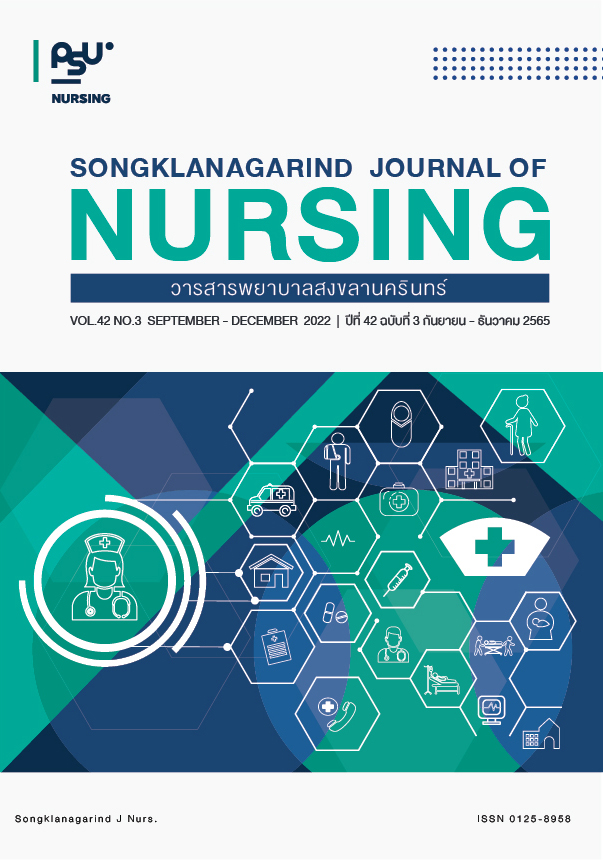Factors Predicting Competency of Professional Nurses in Labor Room, Community Hospitals, Health Service Networks Region 12
Main Article Content
Abstract
Objectives: This predictive research aimed to study the level of competency and factors predicting competency of professional nurses working in the labor room in community hospitals, Health Service Networks Region 12. Methods: Participants were 154 professional nurses working in labor room in community hospitals, Health Service Networks Region 12 with multi-stage sampling. Data were collected by questionnaires consisting of 1) demographic questionnaire, 2) emotional intelligence questionnaire, 3) workplace learning environment questionnaire, and 4) competency of professional nurse questionnaire. The content validities of the latter three questionnaires were judged by the 3 experts with the CVIs values of .98, .87 and .97 respectively. The reliabilities for the latter three questionnaires were tested using Cronbach’s alpha coefficient, yielding the values of .92 .92 and .82 respectively. Data were analyzed using descriptive
statistics and multiple regression. Results: The result showed that the competency of professional nurses in the labor room was at a very high level (M = 4.34, SD = .44). A regression model showed that emotional intelligence, workplace learning environment, and experience in the labor room together significantly predicted the competency of professional nurse in labor room with a coefficient of variation of 57 percent (Adjusted R2 = .57, F = 41.31, p < .001). Conclusion: Nurse administrators can further apply the research findings to enhance competency of maternity nurses such as arranging workshop for improving emotional intelligent and developing workplace learning environment.
Article Details

This work is licensed under a Creative Commons Attribution-NonCommercial-NoDerivatives 4.0 International License.
References
Sukkhee V, Boonamnuaykij B, Pichensophon S, et al. Prevention of maternal death: A model of 3 southern border provinces. Journal of Public Health Nursing. 2020; 34(2): 19-35. Thai.
Department of Health. Thai maternal death ratio per one hundred thousand live birth, health service networks [Internet]. Nonthaburi: Department of Health; 2020 [cited 2021 Jun 4]. Available from: https://www.chiangmaihealth. go.th/cmpho_web/document/200923160083580834.pdf
Health Service Networks Region 12. Summarized of overall result for presenting to inspector of Ministry of Public Health region 12, round 2, budget year 2016 [Internet]. Nonthaburi: Ministry of Public Health; 2016 [cited 2021 Jun 4]. Available from: http://data.ptho.moph.go.th/inspec/doc_ppho_2559_2/Pdf/ส่วนที่%203.%20คณะที่%203.3%20การพัฒนาบุคลากร.pdf
Patthanapisansak C. Health service networks region 12 development plan budget year 2020 [Internet]. Songkhla: Health service networks region 12; 2020 [cited 2021 Jun 4]. Available from: http://www.rh12.moph.go.th//wp-content/uploads/2019/10/3.แผนพัฒนาเขตสุขภาพที่-12.pdf
Thailand Nursing and Midwifery Council. Competence of nurses who graduate bachelor’s degree, master’s degree, doctoral degree in nursing and training program in Nursing [Internet]. Nonthaburi: Thailand Nursing and Midwifery Council; 2018 [cited 2021 Jun 4]. Available from: https://www.tnmc.or.th/images/userfiles/files/004.pdf
Hirunpinyopas A, Prachusilpa G. Predicting factors of competency of professional nurses in coronary care unit. Thai J. Cardio-Thorac Nurs. 2016; 27(2): 71-84. Thai.
Sinwisarn N, Wisesrith W. Relationships between working experiences, educational training, emotional intelligence, working environment, and nurse competency in cardiothoracic surgical ward, the tertiary hospitals. Thai J. Cardio-Thorac Nurs. 2019; 30(1): 46-59. Thai.
Nupinit W, Nilmanat K, Mutchim Y. Selective factors related to intensive care units’ registered nurses’ competency in caring for terminally Ill patients. JTNMC. 2017; 32(4): 94-106. Thai.
Promyaem R, Wisesrith W. Relationships among personal factors, lifelong learning, empowerment of head nurse and orthopedic nurses’ competency, hospitals under the department of medical services. JRTAN. 2019; 20(3): 323-32. Thai.
Matoom B, Jirapongsuwan A, Lagampan S, et al. Factors related to research competency of registered nurse in public health center, Health Department, Bangkok Metropolis. KJN. 2020; 27(2): 7-19. Thai.
Sakboon J, Khumyu A, Deoisres W. Factors related to competencies of perioperative patient care among professional nurses in the regional hospital, Rayong Province. JPNC. 2019; 30(2): 51-61. Thai.
Sulaiman N, Sae-Sia W, Promnoi C. Selected factors for predicting nurses’ competency towards the prevention of incontinence-associated dermatitis (IAD) in critically ill patients. Thai J. Cardio-Thorac Nurs. 2019; 31(2): 174-86. Thai.
Jongruk B, Lertsakornsiri M, Cinnoros S. Factors Associated with competency of professional nurses in caring stroke patients. pnujr. 2019; 11(1): 38-49. Thai.
Gogitrattanagyul S, Pensirinapa N, Sitakalin P. The relationships between personal factors, work motivation, and work expertise of professional nurses in community hospitals, Suphan Buri Province. JTNMC. 2018; 67(2): 8-17. Thai.
Dusitkul Y, Chitpakdee B, Akkadechanunt T. Development of a registered nurse competency framework, labour room, Buddhachinaraj Phitsanulok Hospital. RNJ. 2020; 47(4): 325-35. Thai.
Bureau of Nursing, Department of Medical Services, Ministry of Public Health. Knowledge, skill and key performance of nursing. Nonthaburi: Samcharoen Panich; 2008. Thai.
Goleman, D. Emotional intelligence: Why it can matter more than IQ. Great Britain: CPI Group; 2020.
Senge MP. The Fifth discipline: The art and practice of learning organization. New York: Crown Publishing Group; 2006.
McKim SJ. Healthy work environment. Nurse Lead. 2003; 12(2): 15-22.
Cohen J. Statistical power analysis for the behavior sciences. 2 th ed. New York: Hillsdale NJ; 1988.
Wiratchai N. Guideline of statistic. 2 nd ed. Bangkok: Icon printing; 2012. Thai.
Smuseneto A. The culture of having children in Southern order provinces. JCA. 2019; 19(35): 3-15. Thai.
Legal Affairs Division, Ministry of Public Health. Problems with childbirth. Nothaburi: Ministry of Public Health; 2020. Thai.
Preechakoon B, Molek R, Chuwongin D, et al. Nursing in data technology era. J Chulabhorn Royal Acad. 2021; 3(1): 19-39. Thai.
Orachorn P. Practical criteria for potential upgrade of health service. Department of Health Service Support Journal. 2018; 14(2): 36-46. Thai.
Gantt PS, Agazarian MY. Systems-cantered emotional intelligence: Beyond individual systems to organization system. Int. J. Organ. Anal. 2004; 12(2): 147-69. doi: https://doi.org/10.1108/eb028990.
Khumyu A, Chupan S, Puttaruksa L, et al. Factors related to professional nursing competency among nursing students at a university in the Eastern region. JFONUBUU. 2021; 29(1): 1-12. Thai.
Louaketkit J, Khumyu A, Masingboon K. Factors predicting decision-making ability of charge nurses in private hospitals. JFONUBUU. 2018; 26(2): 49-56. Thai.
Benner P. Novice to expert. AJN. 1982; 82(3): 402-7. doi: https://doi.org/10.2307/3462928.
The Healthcare Accreditation Institute (Public Organization). The healthcare network system standard [Internet]. Nonthaburi: The Healthcare Accreditation Institute (Public Organization); 2014 [cited 2021 Jun 4]. Available from: http://asmhos.moph.go.th/ha/download/1498450280_มาตรฐานเครือข่ายบริการสุขภาพ.pdf


